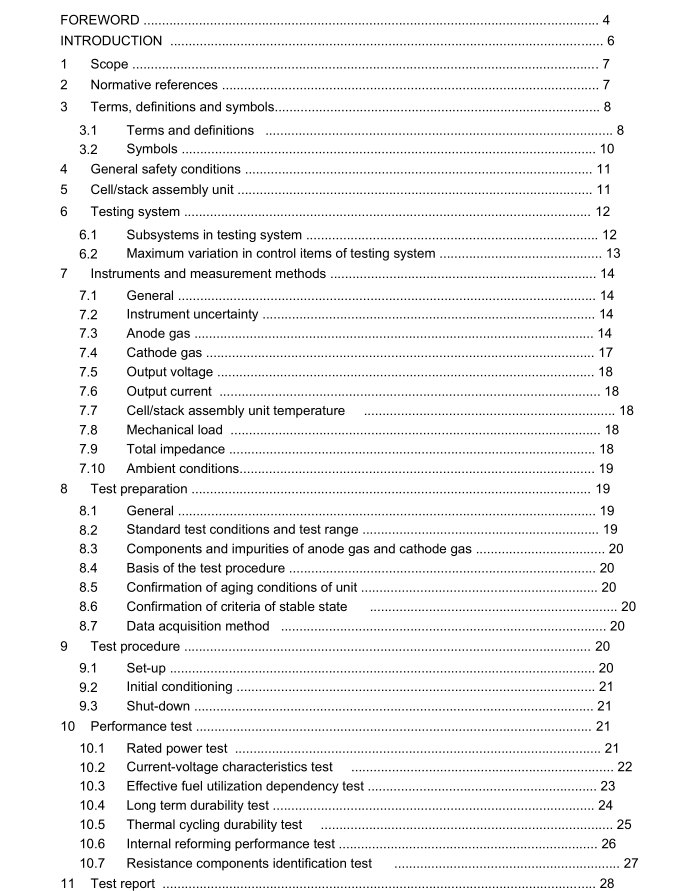IEC 62282-7-2 pdf – Fuel cell technologies – Part 7-2: Test methods – Single cell and stack performance tests for solid oxide fuel cells (SOFCs)

IEC 62282-7-2 pdf – Fuel cell technologies – Part 7-2: Test methods – Single cell and stack performance tests for solid oxide fuel cells (SOFCs)
ISo 8573-1,Compressed air – Part 1: Contaminants and purity classesISO 8756,Air quality -Handling of temperature, pressure and humidity data
ISO 12185,Crude petroleum and petroleum products -Determination of density -OscillatingU-tube method
3Terms,definitions and symbols3.1 Terms and definitions
For the purposes of this document,the terms and definitions given in lEC 60050-485 and thefollowing apply.
ISO and IEC maintain terminological databases for use in standardization at the followingaddresses:
.IEC Electropedia: available at http://www.electropedia.orgl
.Iso online browsing platform: available at http://www.iso.orglobp
3.1.1
cell/stack assembly unit
unit including a single cell or stack, as well as gas supply parts,current collector parts,andany other peripherals as required for power generation tests
3.1.2
active electrode area
geometric electrode area upon which an electrochemical reaction occurs
Note 1 to entry: Usually this is the smaller of the anode and cathode areas.
3.1.3
current density
current divided by the active electrode area
3.1.4
average repeating unit voltage
cellstack assembly unit voltage divided by the number of the cells in a series connection inthe unit
3.1.5
standard temperature and pressureSTP
temperature of 0 “C and an absolute pressure of 101,325 KPa, respectively
3.1.6
anode gas
gas that is supplied to the inlet of the anode of a single cell/stack assembly unit
Note 1 to entry: Such a gas belongs to one of the following categories:
a) pure hydrogen or mixture that contains hydrogen as a principal component with water vapour or nitrogen;
b) reformed gas of raw fuel of soFC such as methane or kerosene premixed with water vapour or air as oxidant;c) simulated gas of reformate that contains hydrogen,water vapour,carbon monoxide,carbon dioxide,methane,nitrogen,etc.,as main components;
d) methane,alcohols and other raw fuels directly supplied in pure form or mixed with water vapour and/or air.3.1.7
cathode gas
gas that is supplied to the inlet of the cathode of a single cell/stack assembly unit
Note 1 to entry: Oxygen and nitrogen are its main components.
3.1.8
current collector
conductive material in a fuel cell that collects electrons from the anode side or conductselectrons to the cathode side
3.1.9
stable state
condition of a cell/stack assembly unit at which the unit is stable enough for any controllingparameter and the output voltage or output current of the unit to remain within its tolerancerange of variation
3.1.10
theoretical current
current when the supplied anode gas or cathode gas is completely consumed inelectrochemical reactions divided by the number of cells in a series connection
3.1.11
effective fuel utilization
ratio of the actual output current of the cell/stack assembly unit to the theoretical current
Note 1 to entry. The effective utilization is the utilization of reactants in the electrochemicalreaction due to theactual current. This may be less than the actualor total utilization if there are gas inlet and cross leaks.
Note 2 to entry.: Causes of less-than-optimal currents include losses due to electronic conduction within thecellstackassembly,gas leaks and anode gas pass-through.
Note 3 to entry: A calculation method of effective fuel utilization is given in Annex B.3.1.12
effective oxygen utilization
ratio of the actual output current of the cell/stack assembly unit to the theoretical current
Note 1 to entry: The effective utilization is the utilization of reactants in the electrochemical reaction due to theactual current.This may be less than the actual or total utilization if there are gas inlet and cross leaks.
Note 2 to entry: A calculation method of effective oxygen utilization is given in Annex c.
3.1.13
maximum effective fuel utilization
highest effective fuel utilization that the unit can operate at,without causing unacceptabledegradation
Note 1 to entry: The acceptable degradation rate is usually obtained from the developer.









